Alaska, known for its icy landscapes and magnificent wildlife, also boasts an array of colorful avian wonders. Discover the four striking orange birds that grace the Alaskan skies and, as a bonus, grab our free photo guide to capture their beauty flawlessly.
The vast forests, vast coastlines, and rugged mountains make Alaska a paradise for many bird species. However, a few birds with noticeable orange markings or hues can be found within its vast borders. Adventure and vibrant plumage await!
Orange Birds Found In Alaska
Note that many birds may only exhibit orange during specific seasons or phases of their lives:
- Varied Thrush: Recognizable for its orange and dark plumage, primarily found in the forests of Alaska.
- Red-necked Grebe: They have a rust-colored neck, especially noticeable during the breeding season.
- Western Tanager: Bright yellow body with an orange-red head. While they do migrate through Alaska, they are typically more prevalent in the western parts of North America.
- Northern Shoveler: Male Northern Shovelers in breeding plumage have an iridescent dark green head and neck, white chest and belly, and rust-brown flanks.
- Rufous Hummingbird: Males have bright orange and iridescent red coloration.
- American Robin: While generally recognized as having a red breast, in certain lighting the breast can appear more orange.
- Brambling: An occasional visitor to Alaska, the male has an orange breast and face.
- Red Crossbill: These birds can vary in color, but some males are bright orange-red.
- Red-faced Cormorant: As the name suggests, it has an orange-red face, though it’s not as bright as some of the other birds on this list.
- Tufted Puffin: During the breeding season, they sport bright orange bills.
American Robins


| Feature | Measurement |
|---|---|
| Scientific Name | Leptotila plumbeicep |
| Length | 10.6-11.8 in |
| Wingspan | — |
| Weight | 160-200 g |
The American Robin is a widely recognized bird species known for its melodious song and early bird tendencies.
Appearance: American Robins are medium-sized birds with a distinctive appearance. Both males and females sport a gray to brown back and a warm red to orange breast and belly and gray wings. They also have a characteristic white eye-ring and a black head, but males are usually darker than females.
Diet: American Robins have a diverse diet that changes depending on the season. In summer, they feed heavily on earthworms, beetles, and other invertebrates, which they catch on the ground. During winter, they mostly eat fruits and berries.
Reproduction: American Robins usually build their nests in trees or shrubs, but they are also known to nest on human-made structures. The female lays a clutch of about 3 to 5 eggs, which she incubates for about 12 to 14 days.
Brambling
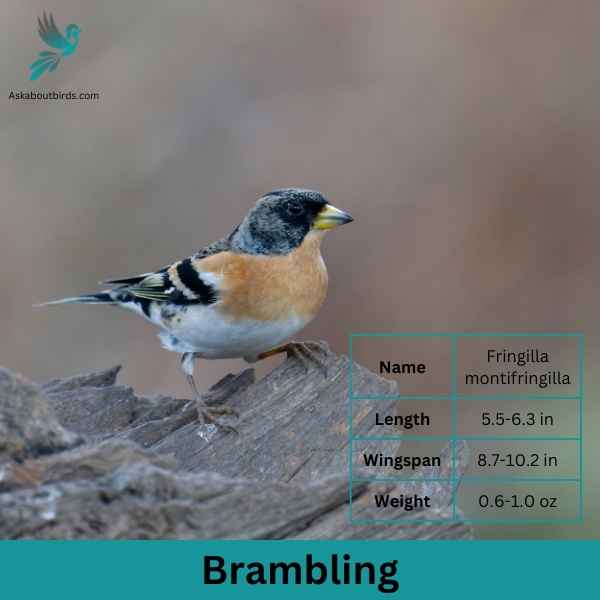

| Feature | Measurement |
|---|---|
| Scientific Name | Fringilla montifringilla |
| Length | 5.5-6.3 in |
| Wingspan | 8.7-10.2 in |
| Weight | 0.6-1.0 oz |
The Brambling is a small passerine bird that belongs to the finch family, commonly found across the northern regions of Europe and Asia.
Appearance: The Brambling sports a distinctive black head, dark upperparts, and white underparts in summer. In winter, its plumage is more subdued, with a buff-orange chest and lighter, mottled upperparts. One of its most recognizable features is its bright orange chest and shoulder patches, regardless of the season.
Diet: The Brambling’s diet mainly consists of seeds, especially in the winter months. During the breeding season, they also feed on insects, which provide necessary protein for growing chicks. In the autumn, they often forage on beech mast, which contributes to their fat reserves for migration.
Reproduction: Bramblings are monogamous birds. During the breeding season, females build a cup-shaped nest in the branches of trees, usually conifers. They lay and incubate 4 to 7 eggs, which hatch in about two weeks. Both parents feed the chicks, which fledge approximately two weeks after hatching. After leaving the nest, the young birds are still taken care of by their parents for some time.
Western Tanager

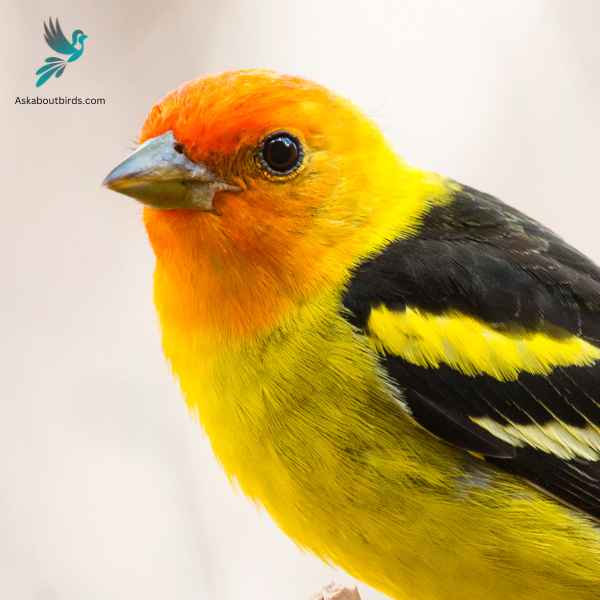
| Feature | Measurement |
|---|---|
| Scientific Name | Piranga ludoviciana |
| Length | 6.3-7.5 in |
| Wingspan | 11.5 in |
| Weight | 24-36 g |
The Western Tanager is a vibrant songbird that graces the forests and woodlands of the western regions of North America, enchanting observers with its colorful plumage and melodious song.
Appearance: The male Western Tanager is renowned for its bright yellow body contrasted with a striking red head and black wings and tail. The females are more subdued in hue, primarily being yellow with grayish wings and back, and lacking the brilliant red head of the males.
Diet: Western Tanagers primarily feed on insects, especially when breeding, but they also incorporate a significant amount of fruits and berries into their diet, especially during migration and winter.
Reproduction: Western Tanagers build their nests high in coniferous trees, often well concealed from potential predators. The female usually lays a clutch of 3 to 5 eggs and takes the primary role in incubation, while both parents are involved in feeding the chicks after they hatch.
Rufous Hummingbird


| Feature | Measurement |
|---|---|
| Scientific Name | Selasphorus rufus |
| Length | 3.1–3.9 in |
| Wingspan | 4.3 in |
| Weight | 0.1–0.2 oz |
The Rufous Hummingbird is a small, brilliantly colored bird known for its impressive migratory journeys and feisty behavior.
Appearance: The male Rufous Hummingbird boasts a gleaming orange-red body with a white chest and an iridescent red throat, called a gorget. The female has green upperparts with rufous-washed flanks and tail. Her throat may have some iridescent patches, but it’s generally whitish.
Diet: Like other hummingbirds, the Rufous Hummingbird primarily feeds on nectar from a variety of flowering plants. They also eat insects and spiders for protein, catching them in flight or plucking them from vegetation.
Reproduction: Rufous Hummingbirds nest in trees, shrubs, or even ferns. The female alone selects the site, builds the nest, and cares for the offspring.
Varied Thrush
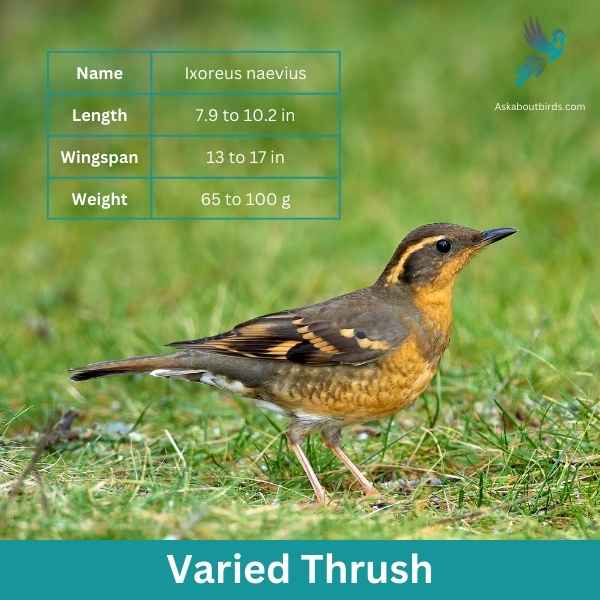

| Feature | Measurement |
|---|---|
| Scientific Name | Ixoreus naevius |
| Length | 7.9 to 10.2 in |
| Wingspan | 13 to 17 in |
| Weight | 65 to 100 g |
The Varied Thrush is a songbird known for its striking appearance and melodious, haunting song that echoes through the dense forests of the Pacific Northwest.
Appearance: The Varied Thrush has a bold pattern. Males display a blue-gray upper body, contrasted with an orange throat and breast, and a black band that extends from the eyes to the neck. The wings have two orange bands and the belly is usually lighter. Females have a similar pattern but are generally more muted in color.
Diet: Varied Thrushes primarily consume insects, berries, and seeds. Their diet can shift seasonally, with insects being more prevalent in the warmer months and berries and seeds making up the bulk of their diet in colder months.
Reproduction: Varied Thrushes nest in trees, often close to the trunk and concealed by dense branches or foliage. The female typically lays a clutch of 3 to 5 eggs, which she incubates.
Red Crossbill
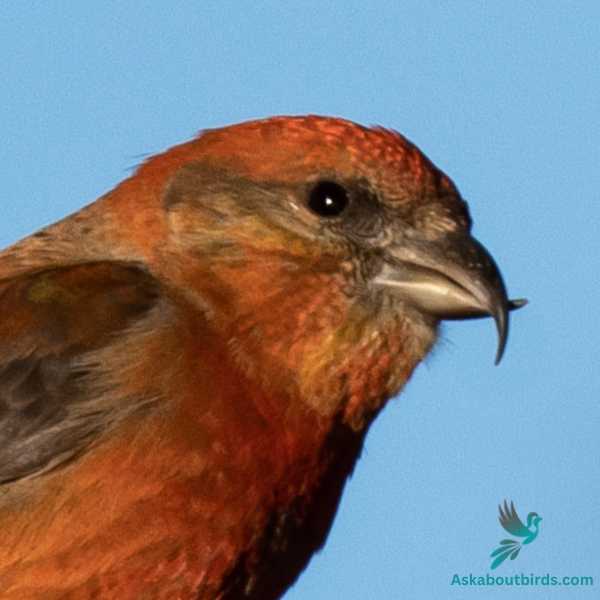

| Feature | Measurement |
|---|---|
| Scientific Name | Loxia curvirostra |
| Length | 20 cm |
| Wingspan | 27–29 cm |
| Weight | 40-53 g |
The Red Crossbill is a peculiar bird species, celebrated for its unique beak structure and vibrant coloration.
Appearance: Red Crossbills are named for their distinctive crossed mandibles, which are adapted to extracting seeds from conifer cones. Male Red Crossbills are usually bright red or orange, while females and juveniles are greenish-yellow. All have dark wings and notched tails.
Diet: The diet of the Red Crossbill is primarily composed of conifer seeds, their unique beak allowing them to access these seeds with ease. This diet includes seeds from pine, spruce, and other types of coniferous trees. They are also known to consume some insects.
Reproduction: Red Crossbills are known for their flexible breeding season, which can occur any time of the year when there is an abundance of food. They typically nest in conifers, where the female lays a clutch of 3 to 4 eggs.
Red-necked Grebe
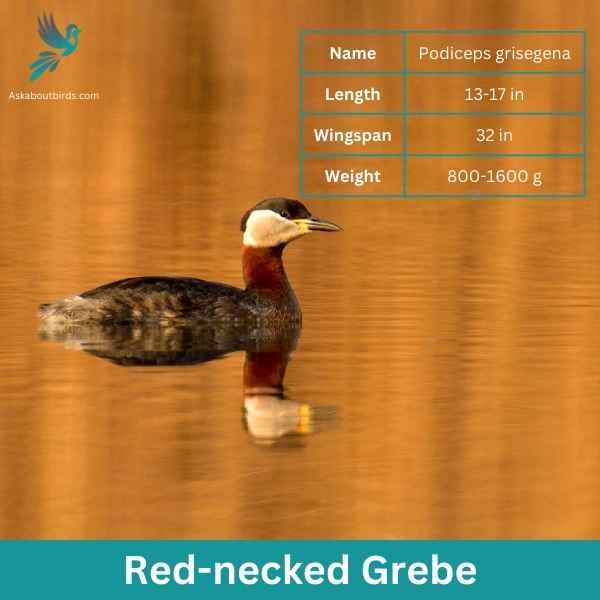
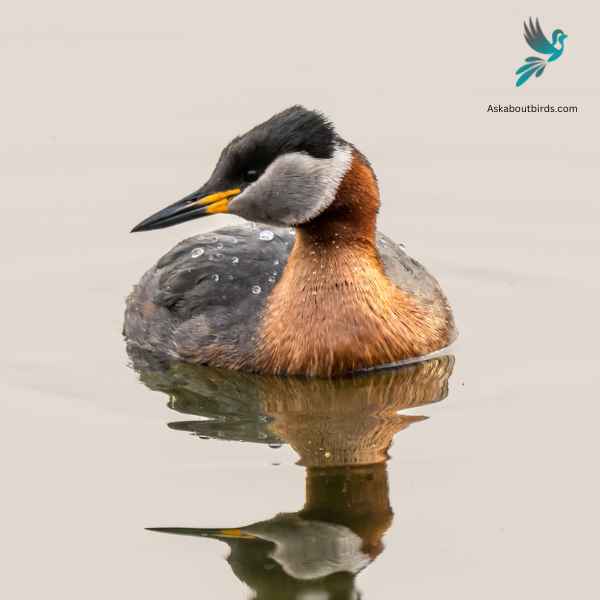
| Feature | Measurement |
|---|---|
| Scientific Name | Podiceps grisegena |
| Length | 13-17 inches |
| Wingspan | 32 inches |
| Weight | 800-1600 grams |
The Red-necked Grebe (Podiceps grisegena) is a striking waterbird known for its distinctive appearance and exceptional diving abilities.
Appearance: During the breeding season, these medium-sized grebes display a vibrant combination of colors, with a captivating red neck and a sleek black cap atop their heads. The rest of their plumage features shades of gray, complemented by a white facial patch and striking red eyes. With their pointed bills and lobed feet.
Diet: Inhabiting a wide range of freshwater environments such as marshes, ponds, and lakes, Red-necked Grebes are opportunistic carnivores with a diverse diet. Their menu consists of small fish, aquatic invertebrates, and occasional amphibians, and they might even consume some plant material.
Reproduction: During the breeding season, they construct floating nests anchored to vegetation or debris, where the female lays a clutch of 3 to 5 eggs. Both parents actively participate in incubating the eggs and raising the downy, precocious chicks, showcasing their dedicated parental care. Though not globally threatened, local populations can be at risk due to habitat loss and human disturbances to their breeding sites.
Where to Spot Alaska’s Orange Birds
Alaska, with its breathtaking and diverse landscapes, offers a unique theater for birdwatching, including those in search of orange birds.
Here are some of the best places to witness this avian spectacle:
- Denali National Park: Covering six million acres, this park is a prime location for birdwatching. Home to a vast range of species, it offers bird lovers the chance to spot the American Robin among its diverse birdlife.
- Kenai Fjords National Park: A coastal paradise, the Kenai Fjords National Park offers a unique blend of marine and terrestrial habitats. It’s an excellent place to observe birds such as the Rufous Hummingbird during their migratory season.
- Potter Marsh Bird Sanctuary: Located near Anchorage, this sanctuary is a haven for many bird species. During spring and summer, it’s not uncommon to see the American Robin, among others.
- Mendenhall Wetlands State Game Refuge: Nestled in the city of Juneau, this refuge boasts a rich variety of bird species. Birdwatchers can expect to see a range of species, including the Varied Thrush.
- Arctic National Wildlife Refuge: This remote, untouched wilderness is an excellent spot for birdwatchers who don’t mind the journey. The Red Crossbill is one of many bird species that can be observed in this vast refuge.
| State’s Orange Birds | Best Spots to See Orange Birds |
|---|---|
| Washington’s Orange Birds | 1. Nisqually National Wildlife Refuge 2. Ridgefield National Wildlife Refuge 3. Mount Rainier National Park |
Please note that the list of birdwatching spots is based on the general diversity of birds and not specifically for orange birds. Additionally, the viewing of orange birds can be seasonal and may vary from year to year.
FAQs on Orange Bird Species Found in Alaska
What types of birds with bright orange patches and rusty orange breasts can be observed in Alaska?
In Alaska, various bird species display bright orange patches and rusty orange breasts. A prime example is the orange crowned warbler. This bird, considered a relatively large songbird, has a diet that consists predominantly of insects. It can often be found in areas of dense vegetation or in the forest canopy.
What species of birds, characterized by black and white wings and gray heads, are attracted to bird feeders?
During the Alaskan winter, bird feeders attract numerous species. One notable bird is the red breasted nuthatch, known scientifically as Sitta canadensis. This species features distinctive black and white wings, gray heads, and some hints of orange feathers beneath their tails. They often feed on sunflower seeds, hence their frequent visits to bird feeders.
What types of birds with light brown or dark blue gray plumage and pointed wings are commonly found in Alaska’s deciduous trees?
In the deciduous trees of Alaska, various birds with pointed wings and plumage ranging from light brown to dark blue gray can be found. One such bird is the yellow warbler. Despite its name, this bird can have patches of light brown or dark blue gray on its body. Its diet mainly consists of small mammals and flying insects.
How do the diet and wintering habits of the orange crowned warbler and yellow warbler, two notable orange birds in Alaska, differ?
Both the orange crowned warbler and the yellow warbler can be found in Alaska and are known for their distinct yellow-green coloring. While they share a general diet of insects, the orange crowned warbler also includes small mammals in its diet. These birds have adapted to the Alaskan winters in different ways. While many yellow warblers migrate to warmer regions, the orange crowned warblers often winter in the southern parts of Alaska, with some individuals even spotted in deciduous trees and the forest canopy of Glacier Bay National Park. Along the Pacific coast of Alaska, birds with bright yellow heads, rusty orange breast, and gray brown bodies stand out, having almost no neck – Red-breasted Nuthatches.




